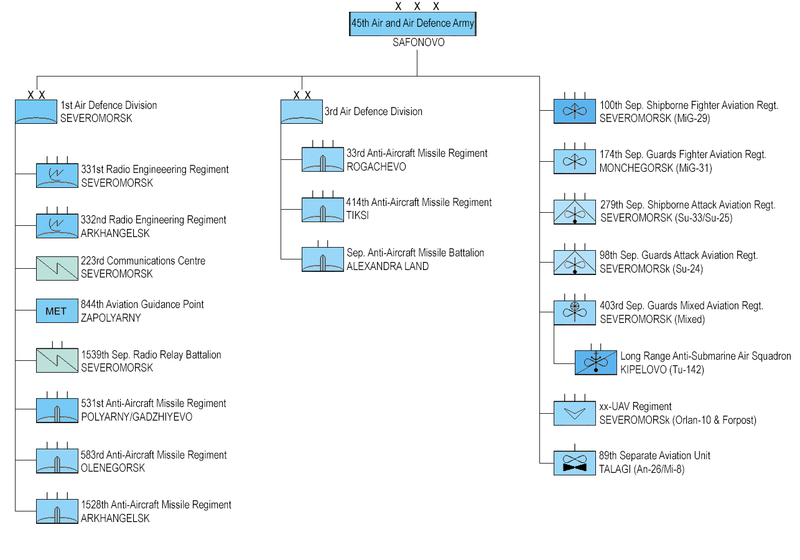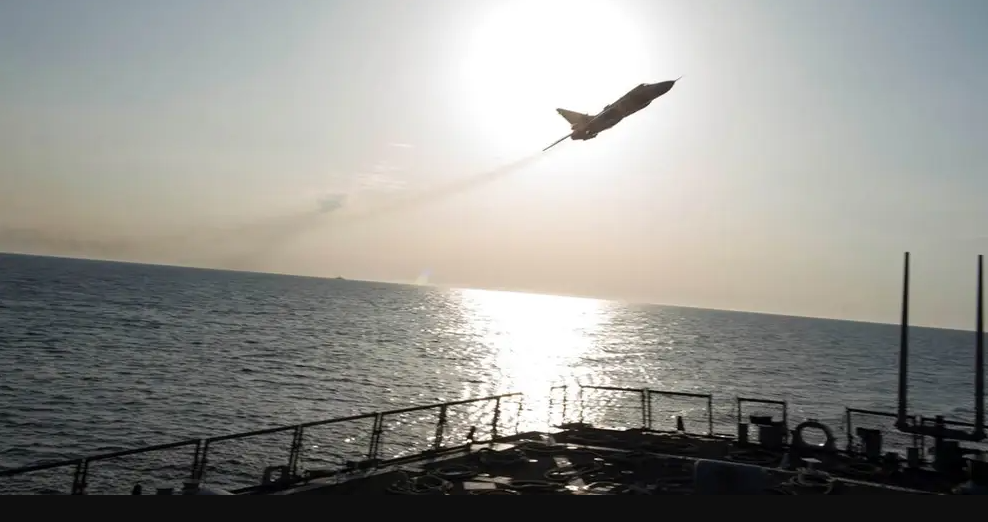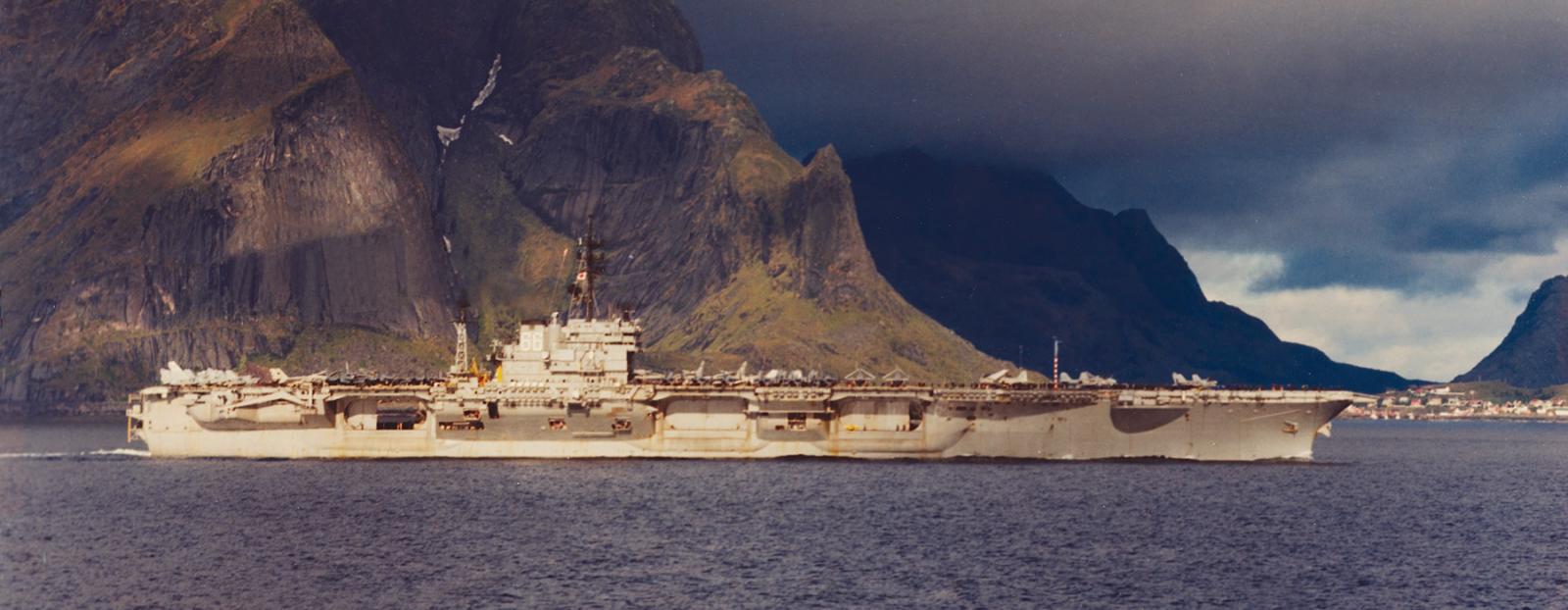Organization and Goals
The Russian Aerospace Forces (VKS) is spread across the Russian Federation, comprising hundreds of thousands of personnel and equipment. The force is tasked with preventing an aerospace strike on the Russian homeland and carrying out aerospace operations against foreign adversaries. Since the fall of the Soviet Union, the VKS has assumed a much more defensive role. Although recent operations in Ukraine demonstrated its ability to project power regionally, the soviet-era strategic ambitions of a globally deployable aerospace force have largely collapsed. However, Russian doctrine and employment in Ukraine have proved that the VKS seeks to achieve an operational advantage in an overwhelming initial strike that not only enables ground forces to move forward but also aims to destroy military power, so that ground forces do not need to occupy an area at all.
In order to control the scope of this analysis, messaging will only be considered concerning the 45th Air and Air Defense Forces Army (AFADA), which is tasked with providing air defense of the arctic, subordinate to the Northern Fleet Joint Strategic Command.

The 45th AFADA employs several Combined Aviation Regiments which fly various tactical aircraft, including MiG-29, MiG-31, Su-24, Su-25, Su-27, Su-33, and Su-34. In addition, several support aircraft ranging from the Il-38, Il-20, An-12, and Tu-134 fly combat support and Intelligence, Surveillance, and Reconnaissance missions. Several regiments are deployed to 45th AFADA airbases in the Northern OSK that fall under the Long Range Aviation (LRA) Command, which flies the Tu-22M bomber. These aircraft defend the Kola Peninsula and Russian military infrastructure from a NATO aerospace attack. These bases also host out-of-area deployments for other LRA assets such as the Tu-95.

Message and Target Audience
Before the fall of the Soviet Union in 1991, the Russian Air Force and Naval Air Forces in the Northern Military District were tasked with projecting power beyond the Norwegian Sea and into the North Sea. The primary adversary was NATO forces, chiefly the United States, Norway, the United Kingdom, and Denmark. In 2022, the target audience remains NATO forces in the North and Norwegian Seas. However, the Northern Fleet is much less capable of projecting power now than in 1991. This resulted in long-range patrols of the Northern Military District, now Northern OSK, aircraft being throttled back in terms of frequency and number of aircraft. The Soviet days of dozens of Tu-95s flying along the Norwegian coast a day have been replaced by the occasional show of force by four to five aircraft, which are quickly intercepted by NATO F-35s.
This primarily defensive posture has resulted in a shift from Soviet strategic messaging of massed infantry flooding across Finnmark to conventional and grey zone tactics targeting critical civilian and military infrastructure in NATO countries, with the background threat of nuclear war. While the 45th AFADA would not issue a specific written message with the intent to deceive NATO forces, its actions would be incorporated into a more extensive messaging campaign by the Ministry of Defense and Foreign Ministry. This messaging campaign would seek to dissuade NATO forces from interfering in the Arctic by employing a wide range of Information Operations techniques, including Military Deception (MILDEC), Electronic Warfare (EW), and Meaconing, intrusion, Jamming, and Interference (MIJI).
The actions of the 45th AFADA during the buildup of Russian forces along the Ukrainian border in the Fall of 2021 and the invasion of Ukraine in February 2022 provide an interesting case study into how aircraft in the Northern OSK can be employed to support an Information Operations Campaign aimed at NATO. Beginning in March 2021, during the breakdown of a tenuous ceasefire between the Ukrainian government and Russian-backed Separatists in Eastern Ukraine, long-range bombers and tactical aircraft from the 45th AFADA were deployed to the Norwegian and North Seas at an unprecedented level, not seen since the 2014 invasion of Ukraine. On March 29, 2021, U.K. and Norwegian interceptors scrambled to intercept ten Russian fLights in the North and Norwegian Seas alone. These interactions were decried in Western media, while Russian government spokespersons denounced the “NATOization” of Ukraine. Russian media also used pictures taken of Russian aircraft by NATO interceptors in several hundred news reports, bragging to their population that Russian aircraft could operate with impunity deep into NATO air defense identification zones.
These flights continued into the Fall of 2021 and increased again in November, along with increased Russian GPS jamming of Norwegian civilian airports. These operations, in conjunction with Foreign Ministry comments on NATO incursion into Ukraine, conveyed the message that the Russian Federation would make direct protection of Ukraine costly for NATO allies in the High North. During the last few weeks leading up to the invasion of Ukraine, aircraft of the 45th AFADA made several reconnaissance patrols in the vicinity of NATO ships along the Norwegian coast. Commercial imagery also revealed that many Russian aircraft had been pulled from covered storage. It was not immediately clear if those aircraft were employed or even operational, but their activity undoubtedly made a stir amongst western intelligence analysts.
However, it was not until the summer of 2022, nearly eight months into the invasion of Ukraine, that 45th AFADA aircraft, and long-range aviation assets deployed out of area to the Northern OSK, began using nuclear-capable assets to attempt to influence NATO support to Ukraine. By August, commercial imagery revealed that Russian Long Range Aviation Command had deployed more than a dozen nuclear-capable bombers to Olenya airbase. These aircraft, along with the Tu-22s that are based there, made ripples in Western media, which claimed that the Russian Federation purposely deployed these aircraft to pressure Finland and Sweden. Although both nations voted to join NATO by mid-Summer, Russian Defense Minister Shoigu directed the deployment of these aircraft and told the press that the Russian military would build twelve new military bases along the Finnish border. Former Russian President Medvedev also told the press that a nuclear-free Baltic was dead. This deployment, in particular, highlights how the Russian Aerospace Forces can be utilized to influence NATO by threatening a massive military response against interference.
How the Message Would Work
Within the hierarchy of persuasion, the tactical actions of aircraft of the 45th AFADA fall into the third tier since it is MILDEC. The Foreign Ministry and the Ministry of Defense can then use this to create higher-tier persuasion, specifically influence, which aims to change the behavior of NATO actors by targeting the civilian population with fears of conventional or even nuclear force against them if their leaders interfere with Russian military activities. This is apparent in Ukraine as the highest levels of the Russian government rely on the hard power of their nuclear-capable forces to influence Western civilian populations against the prospect of nuclear war with Russia. This attempt to persuade Western civilian audiences relies on several cognitive biases and heuristics.
Western societies keenly remember the Cold War and the threat of a nuclear holocaust between the United States and the Soviet Union. During the Reagan administration, which most Americans were alive to experience, the threat of nuclear war was at a historical high, only rivaled by the Cuban Missile Crisis. Throughout the 1980s, Russian aircraft and warships of the Northern Fleet routinely operated within visual distance of NATO forces, much like what is happening in the Arctic Circle today. The threat of nuclear war with the Russian Federation in 2022 over Ukraine invokes the pre-conceived fears of a nuclear exchange with the Soviet Union, which tens of millions of Americans and Europeans wish to avoid. This attempt to persuade Western audiences to give into their confirmation bias that the Russian Federation is just as dangerous as the Soviet Union is put directly at odds with the normalcy bias that has gripped the American public. Since 1991, the United States has enjoyed a time of relative peace amongst the world’s great powers. Besides the threat of terrorist attacks, a nuclear exchange with the Russian Federation is not at the forefront of people’s minds. Thus, even when the geopolitical stakes are high, the American public does not feel a “fight or flight” ultimatum. The activities of the Russian Ministry of Defense, such as employing the nuclear-capable assets of the 45th AFADA, seeks to disrupt that normalcy bias and convince the American public not to support leaders that support Ukraine.
Communicating the Message
MILDEC has been the primary means through which aircraft of the 45th AFADA have served the IO campaigns of the Russian Ministry of Defense and the Foreign Ministry. By executing rehearsals, exercises, maneuvering forces, employing decoys, camouflage, and demonstrations, the 45th AFADA provides numerous opportunities for Russian state-owned media to flout the exploits of the pilots while at the same time decry the actions of NATO interceptors. These missions also seek to prevent the public of adversary nations from supporting leaders who would intervene with Russian plans.
The Message
Since Russian-state-owned media has already exploited the actions of 45th AFADA aircraft in various Information Operations products to influence domestic and international audiences, this analysis will describe that product. On March 22, 2019, the Russian Ministry of Defense published a video shot by the pilot of a Su-27 interceptor. The post claimed that Russian aircraft had “chased” an American B-52 away from Russian airspace in the Baltic Sea. The high-quality footage clearly showed a U.S. bomber, layered with text in Russian saying, “Aerospace interceptors escort U.S. bomber from Russian airspace.” This press release was circulated hundreds of times in pro-Russian Telegram accounts, drawing responses from Western media. This post aimed to show that the bomber leg of the U.S. nuclear triad could easily be intercepted by Russian aircraft. Scenarios like this could easily be exploited by Russian pilots conducting more provocative maneuvers. For example, on April 13, 2016, a Russian Su-24 buzzed the USS Donald Cook in the Black Sea. The Russian fighter flew less than one hundred feet and provided a public relations bonanza for the Russian Ministry of defense. The footage went viral, and several hundred Russian social media accounts, as well as state-owned media, seized the opportunity to call into question the military capability of the U.S. Navy. Both of these examples show how the Russian Ministry of Defense and Foreign Ministry can capitalize on the maneuvers of VKS assets to persuade Western audiences to avoid interfering in Russian activities.

As the War in Ukraine drags on, the 45th AFADA and the Northern Fleet are uniquely positioned to exert pressure on NATO allies by continuing to perform a variety of MILDEC and MIJI missions in the High North. Just as NATO drastically demonstrated during Ocean Venture ’81, perhaps it is time for a massed naval exercise in the High North that not only negates Russian messaging attempts there but overwhelms it. NATO naval exercises in the High North during the 1980’s were highly effective in convincing the Soviet government that they could never outproduce or outmaneuver the combined fleets of NATO, with single exercises comprised of more than 250 ships, perhaps it is time to send that message again.


